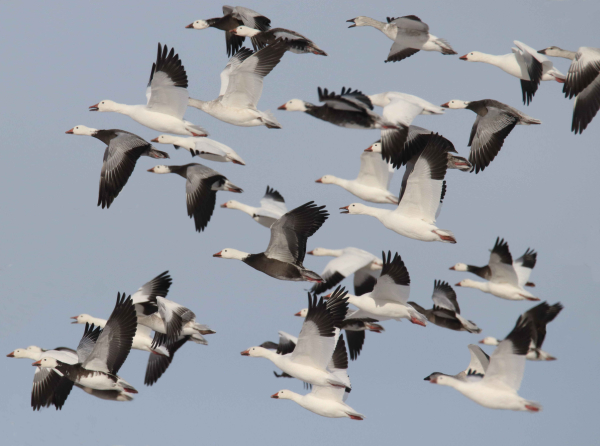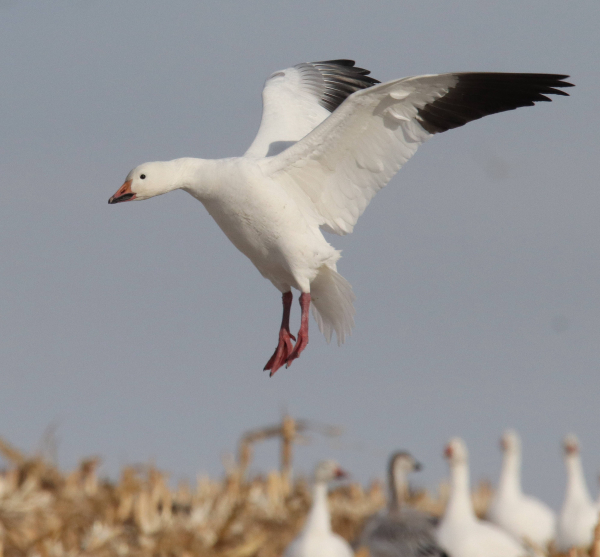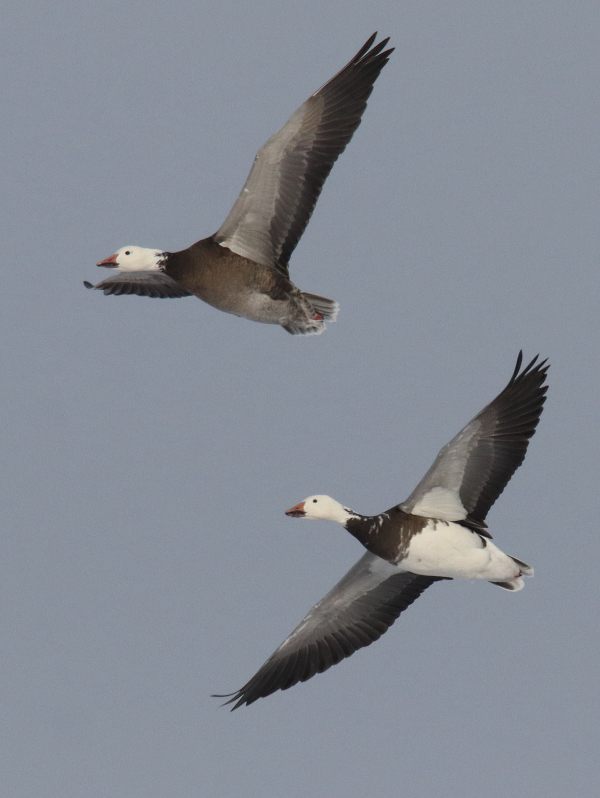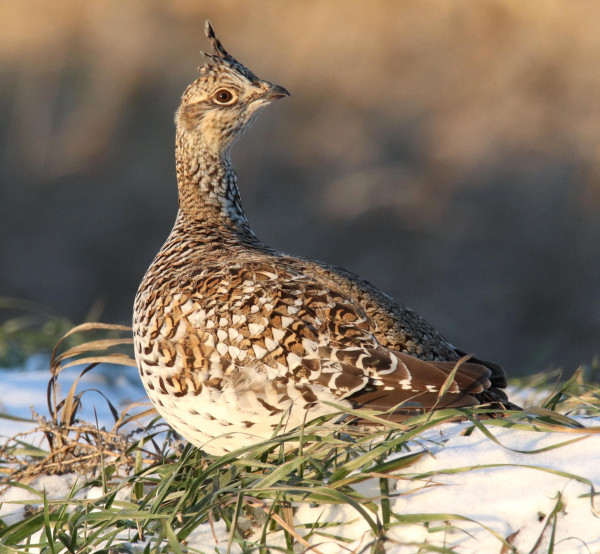
It’s great to be surrounded by flocks of Snow Geese again, in addition to 4 other species of geese, a variety of cold weather ducks, and a few Tundra Swans.

Harvested corn fields were magnets for hungry geese in the surrounding area, providing photo opportunities during sunny periods.

A pair of Snow Geese, including a normally plumaged blue morph Snow with a hybrid blue and white morph as indicated by its white belly. Populations that migrate through the Central Flyway have a higher incidence of blue morph Snow Geese, which make up about 40 percent of the Snows.

A unicorn grouse! This Sharp-tailed Grouse walked up behind the mobile blind and was photographed just as a gust of wind blew the feathers on the crest of its head high.
|
A pretty mild fall changed abruptly! You could feel the anticipation with the promise of an Arctic snowstorm approaching. While a few raptors, namely 4 Northern Harriers, a Red-tailed Hawk, and a Bald Eagle were most obvious during an afternoon drive, and the first Northern Shrike of the season flew across the road, but didn’t offer a better view. Soon thereafter I had to stop as many hundreds of songbirds covered the road for a distance – Lapland Longspurs, obviously a big migrating flock making a migration stop just an hour ahead of the impending snow, were drinking rainwater accumulated on the paved highway that bisected some weedy fields. It was exciting to see such a big flock, and feel the energy created by the birds’ intense fervor, as though they were being chased from the Arctic by the not too distant storm.
Near-freezing temperatures, a strong north wind, and fits of light rain dominated Thursday east of Bismarck, where the snow line seemed to stagnate. The wind blew steam off the choppy surface of area lakes, providing an ominous prelude to an early freeze-up with overnight temperatures in the teens and daytime highs around 30 degrees for 6 consecutive days. How would the huge flocks of geese and other waterfowl react? Would they pour into the area, or keep on going southbound? And how would they react to the Arctic front and temperatures that would freeze the surface of lakes so early in the fall season?
Any minute flocks of geese could begin flying south in Vs high overhead, singing desperate goose music, fleeting sounds that would be taken up by the next flocks in a continuous surge of Arctic-nesting Geese. Will it happen by day? By night? All weekend? Will many flocks stopover to feed on plentiful foods in recently harvested agricultural fields?
An hour before sunset Thursday it began snowing, quickly turning everything white – yikes. As the snow continued into the evening, I could see the wind was creating a full-on blizzard – waay toooo early in the year for that! The first sign of post Arctic blast migration was a flock of Sandhill Cranes I heard calling above my office Friday afternoon. Sandhills aren’t common here, but a few flocks stray this far east during migration; their calls were unexpected and much appreciated, as always. As the afternoon showed promise of the sun breaking through, I decided to see what new birds I could find in the area.
Goose Euphoria
In the moment, I think one of the things that makes me feel most alive and most in touch with nature is being surrounded by thousands of geese, calling to provide a stadium-like sound of goose cheering. I was reminded of that as I photographed from my mobile blind with a quarter mile of geese before me, feeding in 4 associated areas of a harvested corn field and flying from one site to another. Some flocks were within 15 feet of the remote rural road on the east side of Meier’s Lake.
I was parked on the west side of the mass of geese with the sun at my back, photographing the 5 species of geese – mostly Snows and Ross’s Geese, with occasional flocks of Cackling, Canada, and White-fronted Geese – active as family groups, flocks of a dozen to 25, and super-flocks as hundreds took flight unanimously. What fun I had and how alive I felt as I photographed the super-assemblage of geese, sensing the sunlight changing from white to yellow to orange and pink as the nearly full moon brightened in the eastern sky.
It was the first day after the first Arctic snowstorm that brought the geese to the area and although I knew they were on the way, I was still surprised by the presence of the geese just hours after the snow stopped falling – surprised and glad.
Earlier, I photographed another large feeding flock, this one numbering a few hundred rather than several thousand. Composed of the same 5 species of geese, but with the first Cackling Geese of the season a prominent segment of the feeding waterfowl that also included field-feeding flocks of Mallards. North of home, there were even more geese as I caught sight of a few thousand geese flying in a long line of flocks against the fading pink sunset sky – making a beeline from feeding fields to a particularly long lake (I bet that water is cold!).
The outing wasn’t all about the geese; I also observed a Bald Eagle finishing a meal of Mallard, either prey or carrion, but fresh. A female Northern Harrier was flying nearby throughout my observation, and when the Bald Eagle left its remains on top of the snag it was perched on, the hawk made a beeline toward it, yet I was surprised it didn’t land, instead continueing its hunting flight. Other birds included 3 Sharp-tailed Grouse walked into view in my car’s side mirror while I was immersed in the Meier’s Lake goose extravaganza, a nice bonus sighting.
There were also small mixed flocks of songbirds – first Lapland Longspurs and Horned Larks foraging on the edge of the Cackling-based flock, and on my way home I was especially happy to see the first Snow Buntings in a flock mixed with Lapland Longspurs. So the Arctic geese and Arctic songbirds had arrived; now the question became: When will the Arctic birds of prey arrive? Namely the Rough-legged Hawks and Snowy Owls.
Feeder Flicker
It was quite a surprise to see an adult male Northern Flicker fly to the trunk of the ash tree adjacent to my feeding station last Wednesday, providing a close look at the colors and features of its plumage. But when it flew to my sunflower seed feeder, I’m sure my jaw dropped because I’ve never had a flicker feed at any feeder before. Its lack of hesitation to approach and feed on shelled sunflower seeds suggested this was not the first time it visited the feeder, and it returned another time that I witnessed, perhaps more often; but only Wednesday.
After the overnight snow storm, a few House Finches returned to my feeders, and the male and female Hairy Woodpeckers were regulars throughout the week along with White-breasted Nuthatches. Sunday a Dark-eyed Junco fed below my feeders, but I was a bit surprised the storm hadn’t pushed new feeder visitors into the area. I did see a flock of American Tree Sparrows nearby, and as I finished this issue Tuesday afternoon, a Blue Jay called nearby.
Miles of Geese
By Sunday I gave up on trying to estimate goose numbers by the tens of thousands and began measuring the numbers of geese by the miles of ground they covered as they were feeding in harvested corn fields. I encountered the first and biggest group 1½ miles northwest of home, and according to my car’s odometer it measured 3 miles of geese – mostly Snow and Ross’s Geese, but with more Cackling Geese than other days, and White-fronts and Canadas too. There were also ¾ of a mile of geese, and 2 half-mile flocks of feeding geese, plus 2 other flocks of a few hundred geese, and a stream of goose flocks flying low that continued for a half-mile.
Overall, it was amazing, and I’m under the impression that the farther I would have driven, the more miles of geese I would have found. It could have been the peak of migration that third day of below freezing temperatures, including an overnight low in the teens. Most of the marshes had a cover of ice, and the rest would likely have one before dawn Monday, leaving only the largest, deepest lakes with open water – the goose lakes.
There were many flocks of ducks in the area too, mostly Mallards, but also a large flock of Northern Shovelers, scattered Gadwalls and Ruddy Ducks, plus a surprising number of Hooded Mergansers with one flock numbering 23 and another numbering more than 150 where I also saw a few Bonaparte’s Gulls on the hunt. To top it off, there was a Tundra Swan feeding among a few Canada Geese and several Mallards on the edge of a lake about 1½ miles north of my office.
I counted 3 Northern Harriers in the area, and I thought I spied a hawk on a distant tree branch, very dark colored – possibly a dark morph Harlan’s Red-tailed Hawk, or maybe a dark-morph Rough-legged Hawk. I drove closer down a muddy section line road, trying not to get high-centered, and checked the raptor with my binoculars a couple times without being able to get a true ID. But finally I saw that this barely Red-tail sized raptor was actually a small male Golden Eagle, very rare in the area; and as it took flight I saw it was a first fall Golden with a characteristic white tail band and white circles of plumage on the underside of each wing.
The only problem with all these great birds so close to home was that it was extremely overcast with periodic snow squalls, so with no sunlight to work with, photography was all but impossible. That was tough on me, especially considering how trusting and accommodating the geese and most other birds were. Geese were feeding right up to the edge of harvested corn fields, just a ditch away from the road, but I did take some time to study the varied plumages among the Snow Geese and to appreciate close looks at the other species – while hoping for sunshine Monday with the geese continuing their stopover cornfest.
Indeed, Monday and Tuesday mornings each produced an hour of exciting goose photography at close quarters, and although all the area marshes had a cover of thin ice, some of the deep lakes had portions of ice too. Monday an added treat was to find 5 Tundra Swans just a half-mile away, sleeping or resting deeply with their heads tucked into the plumage on their back as they laid on the ice at Melody’s Marsh. And Tuesday, hundreds of geese were feeding just a half-mile west of home with flocks of geese passing overhead, adding another level of wild nature to my corner of the world. Enjoy this exciting period of fall migration!
Article and photos by Paul Konrad
Share your bird sightings and photographs at editorstbw2@gmail.com